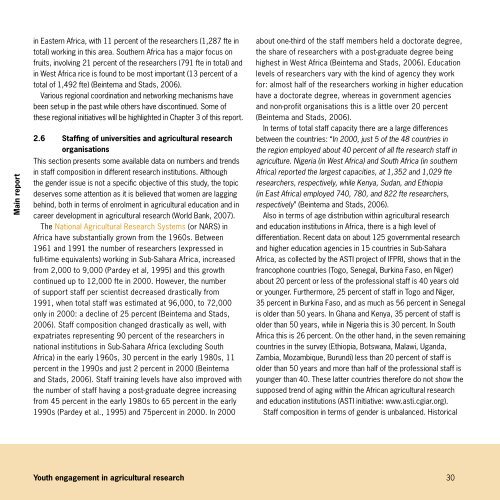Youth engagement in agricultural research - Are you looking for one ...
Youth engagement in agricultural research - Are you looking for one ...
Youth engagement in agricultural research - Are you looking for one ...
Create successful ePaper yourself
Turn your PDF publications into a flip-book with our unique Google optimized e-Paper software.
Ma<strong>in</strong> report<br />
<strong>in</strong> Eastern Africa, with 11 percent of the <strong>research</strong>ers (1,287 fte <strong>in</strong><br />
total) work<strong>in</strong>g <strong>in</strong> this area. Southern Africa has a major focus on<br />
fruits, <strong>in</strong>volv<strong>in</strong>g 21 percent of the <strong>research</strong>ers (791 fte <strong>in</strong> total) and<br />
<strong>in</strong> West Africa rice is found to be most important (13 percent of a<br />
total of 1,492 fte) (Be<strong>in</strong>tema and Stads, 2006).<br />
Various regional coord<strong>in</strong>ation and network<strong>in</strong>g mechanisms have<br />
been set-up <strong>in</strong> the past while others have discont<strong>in</strong>ued. Some of<br />
these regional <strong>in</strong>itiatives will be highlighted <strong>in</strong> Chapter 3 of this report.<br />
2.6 Staff<strong>in</strong>g of universities and <strong>agricultural</strong> <strong>research</strong><br />
organisations<br />
This section presents some available data on numbers and trends<br />
<strong>in</strong> staff composition <strong>in</strong> different <strong>research</strong> <strong>in</strong>stitutions. Although<br />
the gender issue is not a specific objective of this study, the topic<br />
deserves some attention as it is believed that women are lagg<strong>in</strong>g<br />
beh<strong>in</strong>d, both <strong>in</strong> terms of enrolment <strong>in</strong> <strong>agricultural</strong> education and <strong>in</strong><br />
career development <strong>in</strong> <strong>agricultural</strong> <strong>research</strong> (World Bank, 2007).<br />
The National Agricultural Research Systems (or NARS) <strong>in</strong><br />
Africa have substantially grown from the 1960s. Between<br />
1961 and 1991 the number of <strong>research</strong>ers (expressed <strong>in</strong><br />
full-time equivalents) work<strong>in</strong>g <strong>in</strong> Sub-Sahara Africa, <strong>in</strong>creased<br />
from 2,000 to 9,000 (Pardey et al, 1995) and this growth<br />
cont<strong>in</strong>ued up to 12,000 fte <strong>in</strong> 2000. However, the number<br />
of support staff per scientist decreased drastically from<br />
1991, when total staff was estimated at 96,000, to 72,000<br />
only <strong>in</strong> 2000: a decl<strong>in</strong>e of 25 percent (Be<strong>in</strong>tema and Stads,<br />
2006). Staff composition changed drastically as well, with<br />
expatriates represent<strong>in</strong>g 90 percent of the <strong>research</strong>ers <strong>in</strong><br />
national <strong>in</strong>stitutions <strong>in</strong> Sub-Sahara Africa (exclud<strong>in</strong>g South<br />
Africa) <strong>in</strong> the early 1960s, 30 percent <strong>in</strong> the early 1980s, 11<br />
percent <strong>in</strong> the 1990s and just 2 percent <strong>in</strong> 2000 (Be<strong>in</strong>tema<br />
and Stads, 2006). Staff tra<strong>in</strong><strong>in</strong>g levels have also improved with<br />
the number of staff hav<strong>in</strong>g a post-graduate degree <strong>in</strong>creas<strong>in</strong>g<br />
from 45 percent <strong>in</strong> the early 1980s to 65 percent <strong>in</strong> the early<br />
1990s (Pardey et al., 1995) and 75percent <strong>in</strong> 2000. In 2000<br />
about <strong>one</strong>-third of the staff members held a doctorate degree,<br />
the share of <strong>research</strong>ers with a post-graduate degree be<strong>in</strong>g<br />
highest <strong>in</strong> West Africa (Be<strong>in</strong>tema and Stads, 2006). Education<br />
levels of <strong>research</strong>ers vary with the k<strong>in</strong>d of agency they work<br />
<strong>for</strong>: almost half of the <strong>research</strong>ers work<strong>in</strong>g <strong>in</strong> higher education<br />
have a doctorate degree, whereas <strong>in</strong> government agencies<br />
and non-profit organisations this is a little over 20 percent<br />
(Be<strong>in</strong>tema and Stads, 2006).<br />
In terms of total staff capacity there are a large differences<br />
between the countries: “In 2000, just 5 of the 48 countries <strong>in</strong><br />
the region employed about 40 percent of all fte <strong>research</strong> staff <strong>in</strong><br />
agriculture. Nigeria (<strong>in</strong> West Africa) and South Africa (<strong>in</strong> southern<br />
Africa) reported the largest capacities, at 1,352 and 1,029 fte<br />
<strong>research</strong>ers, respectively, while Kenya, Sudan, and Ethiopia<br />
(<strong>in</strong> East Africa) employed 740, 780, and 822 fte <strong>research</strong>ers,<br />
respectively” (Be<strong>in</strong>tema and Stads, 2006).<br />
Also <strong>in</strong> terms of age distribution with<strong>in</strong> <strong>agricultural</strong> <strong>research</strong><br />
and education <strong>in</strong>stitutions <strong>in</strong> Africa, there is a high level of<br />
differentiation. Recent data on about 125 governmental <strong>research</strong><br />
and higher education agencies <strong>in</strong> 15 countries <strong>in</strong> Sub-Sahara<br />
Africa, as collected by the ASTI project of IFPRI, shows that <strong>in</strong> the<br />
francoph<strong>one</strong> countries (Togo, Senegal, Burk<strong>in</strong>a Faso, en Niger)<br />
about 20 percent or less of the professional staff is 40 years old<br />
or <strong>you</strong>nger. Furthermore, 25 percent of staff <strong>in</strong> Togo and Niger,<br />
35 percent <strong>in</strong> Burk<strong>in</strong>a Faso, and as much as 56 percent <strong>in</strong> Senegal<br />
is older than 50 years. In Ghana and Kenya, 35 percent of staff is<br />
older than 50 years, while <strong>in</strong> Nigeria this is 30 percent. In South<br />
Africa this is 26 percent. On the other hand, <strong>in</strong> the seven rema<strong>in</strong><strong>in</strong>g<br />
countries <strong>in</strong> the survey (Ethiopia, Botswana, Malawi, Uganda,<br />
Zambia, Mozambique, Burundi) less than 20 percent of staff is<br />
older than 50 years and more than half of the professional staff is<br />
<strong>you</strong>nger than 40. These latter countries there<strong>for</strong>e do not show the<br />
supposed trend of ag<strong>in</strong>g with<strong>in</strong> the African <strong>agricultural</strong> <strong>research</strong><br />
and education <strong>in</strong>stitutions (ASTI <strong>in</strong>itiative: www.asti.cgiar.org).<br />
Staff composition <strong>in</strong> terms of gender is unbalanced. Historical<br />
<strong>Youth</strong> <strong>engagement</strong> <strong>in</strong> <strong>agricultural</strong> <strong>research</strong> 30
















![CynefinFramework final [Read-Only]](https://img.yumpu.com/19017304/1/190x135/cynefinframework-final-read-only.jpg?quality=85)